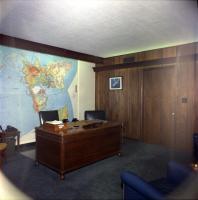Type Of Activity | Crisis Management |
Location | |
Location | Washington DC |
Date of Activity | 1961 to Present |
Coordinates | |
 |
| The office in the Situation Room under President John F. Kennedy (1961) |

 |
| The White House Watch Center |
 |
| Conference Room part of the Situation Room (1980) |

 |
| President Ronald Reagan, “wanted to be in the place where things happened.” |
The Situation Room has been central to major historical moments, including the events of September 11, 2001. After the attacks began, the room was staffed with three duty officers, a communicator, and a few others who refused to evacuate. This was also true with the WHCA Signal board and Comm Center in the OEOB both stayed fully operational.
Recalling the morning of September 11, 2001, after two planes had already crashed into the World Trade Center’s twin towers, American flight 77 began turning south, away from the White House. It continued heading south for roughly a minute, before turning west and beginning to circle back. This news prompted the Secret Service to order the immediate evacuation the White House and the immediate relocation of the Vice President to the Presidential Emergency Operations Center (PEOC) to a little used cold war bunker located below the East Wing of the White House.
Once inside, Vice President Cheney and the agents paused in an area of the tunnel that had a secure phone, a bench, and television. The Vice President asked to speak to the President, but it took time for the call to be connected. He learned in the tunnel that the Pentagon had been hit, and he saw television coverage of smoke coming from the building,
There were so many people running toward what everybody knew was a potential target the White House Situation Room peaked at 27 bodies that refused to evacuate. The WHCA staffed Signal switchboard and Comm. Center located in the adjacent OEOB also remined when the White House was evacuated.
 |
The president and his national security team as they "receive an update on the mission against Osama bin Laden |
 |
| Situation Room as it is configured today |
A comprehensive renovation in 2023 further modernized the Situation Room, with enhanced security and technology upgrades costing over $50 million. The new facility features modern aesthetics, advanced communication systems, and improved security measures. The main meeting room, named the "Kennedy Room," honors President Kennedy's role in establishing the Situation Room. It includes a large wooden table with 12 chairs, surrounded by screens capable of displaying classified and unclassified information. The room is equipped to handle secure calls and video feeds from agencies worldwide.
 |
| Completed renovations of the Situation Room of the White House as seen, Wednesday, August 16, 2023 |
Everything, from the wood to the carpet, was picked, with security and acoustics in mind. There are rows of built-in speakers on the ceiling and digital clocks on the walls that are set based on the info that is needed -- but that also always show the time zone that the president is in.
The seal behind the desk rotates depending on who is leading the meeting: the president, vice president, the White House national security adviser and so on. On one huge wall there are eight screens and then there are three screens on each side wall of the room. Classified feeds from any agency and around the world can be plugged in, secure calls with foreign leaders can be set up -- and a lot more that officials wouldn't disclose.
 |
| The main meeting room has been designated the "Kennedy" room |
The President and Vice President still have their own door to the facility while everyone else, from the Secretary of State to the chair of Joint Chiefs of Staff and beyond, must enter through the main reception area: a row of desks with wood paneling and grey stonework.
One wing of the space is a big room with walls of monitors and 17 workstations, all with several individual monitors on the "watch floor". On-duty officers, who are mostly detailed to the White House from the Pentagon or departments of State and Homeland Security, sit at these desks in 12-hour shifts, monitoring, taking in and distributing classified intelligence. It's the backbone of the facility.
 |
This is the "watch floor," a command center for the Situation Room where secure feeds are coordinated |
The Situation Room remains the nerve center for the White House's crisis management, staffed 24/7 by officers from various agencies. These officers monitor, analyze, and distribute intelligence, ensuring the President and senior officials are informed and prepared for any situation.


No comments:
Post a Comment